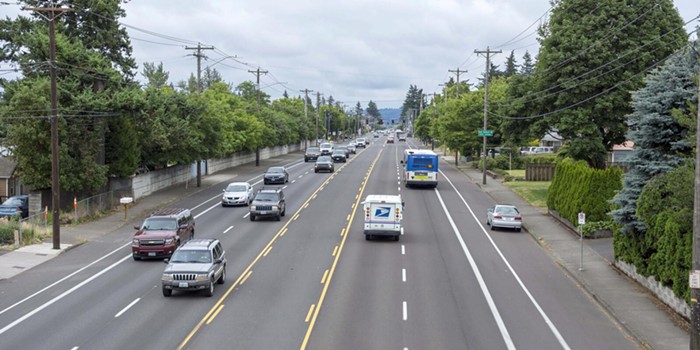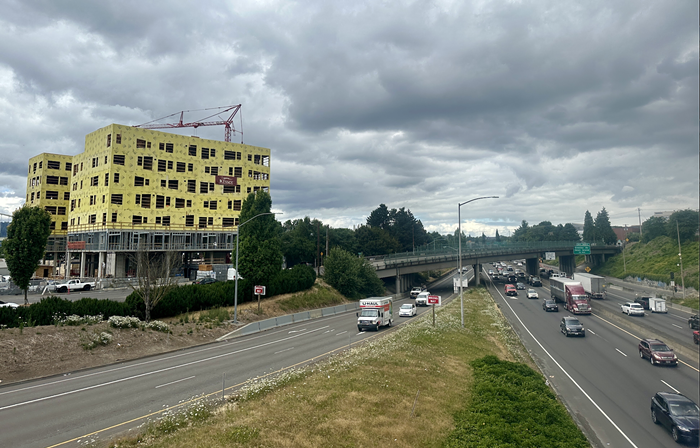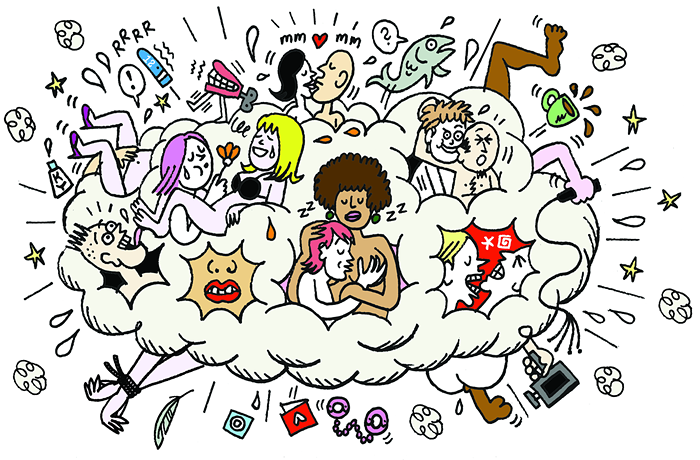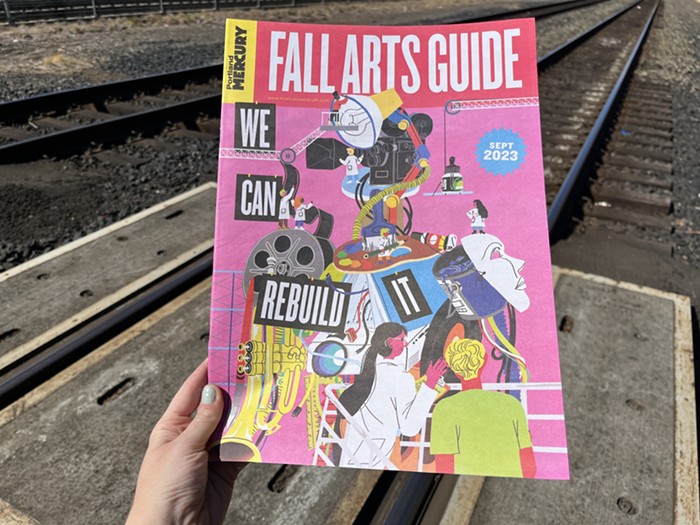A recent study from the University of Washington (UW) revealed new insights about the prevalence of fentanyl and methamphetamine on public transit in Portland.
The UW study showed the presence of airborne remnants of both drugs on buses and light rail cars in Seattle and Portland, though transit agencies say the amounts are minuscule—one public transit leader compared the amount of substance found to "one-thousandth of a grain of sugar"—and don’t pose a threat to public health. It's also unclear from the study whether or not the residue found in public transit vehicles was directly caused by people using drugs onboard. Still, public transportation leaders think the findings warrant taking action on public drug use on TriMet buses and light rail trains.
On Sept. 7, TriMet posted to social media about an upcoming "crackdown on public drug use," calling on "state and local officials and lawmakers to enact policy changes and enforcement to help curb this epidemic."
"We know public drug use on transit is a serious safety concern for our riders and employees, and that it makes TriMet a less appealing travel option," the post said. The statement was met with mixed reception, with some people commending the agency for taking a strong stance while others expressed fears about TriMet increasing policing on public transit.

In a blog post, TriMet outlined a plan to deal with illegal drug use on public transit vehicles, listing measures like increased security personnel and partnerships with local law enforcement to combat drug use. The announcement came in the immediate aftermath of a unanimous Portland City Council effort to criminalize hard drug use, which will require changes in Oregon law to enforce.
During a time when public transit ridership has failed to return to pre-pandemic levels, many transportation advocates are looking for a solution to get people back on the bus—and TriMet leaders think a security crackdown could be one solution.
While many transportation experts acknowledge the crisis of addiction in Portland, they advise caution and nuance when interpreting the findings of the UW study. Some advocates also warn against relying on policing as an addiction response tactic, which they say fails to address the root cause of the problem.
The UW study's findings
Between March 27 and June 22, UW researchers collected air and surface samples for fentanyl and methamphetamine from 11 buses and 19 train cars in Portland and Seattle's public transit systems. Nearly all of the 78 air samples and 102 surface samples collected contained detectable methamphetamine—100 percent and 98 percent, respectively. The report indicates 25 percent of air samples and 46 percent of surface samples collected contained detectable fentanyl. But, the report points out, "detection of fentanyl or methamphetamine by the lab does not mean it poses a health risk to operators or the riding public."
The research was conducted after bus and light rail operators in Seattle filed safety incident reports about drug use on public transit vehicles. According to the Seattle Times, some bus drivers "stopped driving because of headaches, dizziness or difficulty breathing."
It's unclear whether or not passive exposure to surface or air residue from fentanyl and methamphetamine can result in dangerous health outcomes. The UW report states the levels of drugs found in the study are unlikely to impact the riding public, but it's less clear if or how much passive exposure to fentanyl and methamphetamine can impact transit operators, who spend much more time in the vehicles.
This isn’t the first time TriMet has attempted to address drug use on its transit vehicles. Last year, the agency sent out a memo to its workforce about the impacts of fentanyl use on public trains and buses, proposing more transit security officers and other measures to combat the alleged drug use.
While much of the discussion around the UW study has implied drug residue is the result of people smoking fentanyl or methamphetamine on public transit, this isn't clear from the research. UW researchers did not directly assess exposure determinants, such as "whether or not smoking events definitely occurred" when tests were running. Among other limitations, the researchers also point out the assessment was limited in scope and "cannot be taken to be representative of all vehicles, routes, or runs, both in the Pacific Northwest and throughout the country."
After the study was published, the Oregon and Washington Poison Centers released a joint statement to "put [the] data in perspective." Oregon's Poison Center is housed at Oregon Health and Science University (OHSU).
"As physicians who are medical toxicologists and Medical Directors of the Poison Centers of Washington and Oregon, we find that the results of the study are no surprise," the statement reads. "Smoking in a public place produces very small amounts of that substance and we can identify those substances in the air and on surfaces with modern laboratory methods."
The statement added that people who use public transit "should continue to feel safe doing so."
Dr. Rob Hendrickson, medical director of the Oregon Poison Center, said in a press briefing that “in most cases, an exposure [on public transit] would be hundreds to thousands of times lower than what we would expect to cause clinical effects.”
The toxicology experts noted the study was meant to determine whether drugs could be detected on public transit. The results are “reflective of the volume of drug use currently in our communities and a reminder for the community to develop solutions to decrease drug use over the long term."
But potential health impacts aren't the only problem: the UW study and public transportation leaders also point out the impact that perceived danger can pose for passengers and transit operators. In this case, perceived threat may be the biggest factor informing people's decisions about whether or not to ride public transit.
Public safety and the ridership crisis
Like in many other cities across the country, ridership on TriMet buses and MAX trains has been down since the beginning of the pandemic. While factors like an increased remote workforce and ongoing Covid concerns have likely played a substantial role, some TriMet leaders point to public safety concerns related to drug use as a reason for lower ridership.
Andrew Wilson, TriMet's executive director of safety and security, spoke in favor of banning public drug use in Portland at a Portland City Council meeting on September 6.
"The convergence of behavioral health issues, drug use and addiction, and homelessness in the communities we serve [is] negatively impacting our riders and our employees. The open drug use is extending onto our transit system despite our expanding security efforts," Wilson said. "It is important that public transit is safe, particularly for those who rely on it. Perception often is reality, and open drug use on and around transit creates a perception that transit is unsafe, which hurts transit ridership and the vitality of downtown."
The UW study also recognizes perceived danger as a risk for operators and the riding public.
"Observing drug use in a bus or train can be stress-inducing... and may increase feelings of stress, anxiety, or job dissatisfaction," the study states. "For individuals who may be in recovery or have had family or loved ones impacted by drug use, these feelings may be particularly heightened."
Public safety concerns about public transit aren’t limited to drug use. Early this month, two 17-year-old boys were stabbed at a MAX platform in Portland's Lents neighborhood. Both survived without life-threatening injuries. The suspect has been charged with assault and bias crime for the attack, with police saying he stabbed the boys because of his "perception" of their race, though details about the victims' race have not been released.
Likely the most notable example of danger on the TriMet system occurred in 2017, when two men died and one was seriously injured after they defended two young Black teenage girls from a racist and Islamophobic attacker.
In an email to the Mercury, TriMet Communications Director Roberta Altstadt said the agency “would not be able to speculate” on any correlation between drug use and violent attacks.
Organizers with Bus Riders Unite (BRU), a public transit rider union housed by OPAL Environmental Justice Oregon, attribute low ridership to other causes. In an email to the Mercury, a BRU organizer said after speaking to “dozens of transit-dependent riders” about their primary concerns with TriMet last weekend, the top issues they heard about from riders involve the recent systemwide fare increase, reduced bus service, and lagging transit schedules.
“Not a single rider spoke to illicit drug use on public transit,” the BRU organizer wrote.
TriMet leans on bolstered security, social services as solutions
Among TriMet’s proposed solutions to the prevalence of drugs on public transit is increased police and non-police enforcement. In a September 7 blog post, TriMet stated they have doubled the number of personnel on their security teams since the start of 2022, and security officers will “inform anyone seen smoking on board that it is not allowed,” escalating to contacting supervisors and/or the police if the person is noncompliant. The blog post also states that TriMet has 46 customer safety supervisors—unarmed patrollers—on staff compared to 18 last year.
The agency is also relying on its Safety Response Team: a group of 58 personnel who “connect people in need on and around our transit system with social services such as shelters, mental health resources, and addiction services.”
Drug use isn’t the only code violation TriMet hopes to combat with increased security. Safety supervisors will also enforce fares and attempt to “reduce inappropriate behaviors and activities.” Last month, TriMet began limiting access to the Hollywood Transit Center MAX platform to paying customers by requiring fare payment to use the elevator. The agency says the effort helped “discourage misuse” of the station, and they plan to expand the process system wide.
Transportation justice advocates are supportive of programs like the Safety Response Team. But TriMet’s embrace of Portland City Council’s more punitive approach to drug use may signal the agency is heading in a different direction—though the agency maintains they want to “reduce interaction with law enforcement that leads to criminal charges, unless absolutely necessary.”
Marisa Zapata, an urban studies and planning professor at Portland State University (PSU), said not all efforts to increase safety are created equal.
"When you increase policing, there is a whole set of people who feel less safe, and then other people who feel more safe," Zapata said in an interview with the Mercury. "You have to ask first and foremost: whose safety needs are you trying to meet?"
Zapata leads the PSU Homelessness Research & Action Collaborative, and she has researched the intersections of homelessness and public transportation. While homelessness and drug use are two distinct issues, addiction and homelessness can be cyclical, and drug use by those living on the street is far more visible in public spaces.
"The first thing we need to do is to be able to offer stable housing," Zapata said.
Another solution endorsed by both the UW study and TriMet: enhanced filtration and cleaning protocols. Zapata pointed out this would also be helpful for increasing perceptions of safety regarding the presence of unhoused passengers generally.
“One of the consistent findings that we had around homelessness was if people are concerned about trash being left behind or something like that, just clean things more,” Zapata said.
Enhanced cleaning and filtration mechanisms would also help to combat the airborne threat that still lingers and, in fact, is worsening as another surge begins: COVID. TriMet, along with other public transit systems around the country, dropped its mask mandate back in April 2022.
“What else is on the trains that could actually be a public safety and health threat? How much COVID is in the air?” Zapata asked. “Is this even the biggest issue in terms of what you could contract on a train? I'm still more focused on COVID.”




















